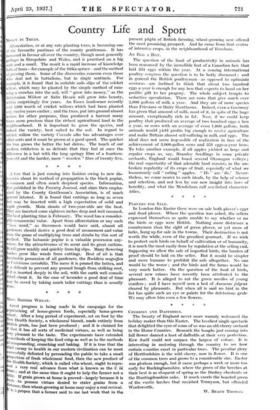AN EGG A Div.
The question of the limit of productivity in animals has been rearoused by the incredible feat of a Canadian hen that laid 351 eggs within the year. At a coming international poultry congress the question is to be hotly discussed ; and in general the British poultryman—as opposed to optimists overseas—are inclined to think that about two hundred eggs a year is enough for any hen that expects to hand on her prolific gift to her progeny. The whole subject tempts to seductive speculation. There are cows that give much over 2,000 gallons of milk a year. And they are of more species than Friesians or Dairy Shorthorns. Indeed, even a Guernsey has given that amount of milk, most of it, in spite of the huge amount, exceptionally rich in fat. Now, if we could keep poultry that produced an average of two hundred eggs a hen a year, or cows with an average of even 1,000 gallons, both animals would yield profits big enough to revive agriculture and make Britain almost self-sufficing in milk and eggs. The ideal does not seem impossible of realization in face of the achievement of 3,000-gallon cows and 351 eggs-a-year hens. To take another example, if all apples yielded as large and regular crops as, say, Bramley Seedlings in some private orchards, England would boast several Okanagan valleys ; the real superiority of that adorable land consists in the un- broken regularity of its crops of fruit, especially of what we humorously call " eating " apples. " Ifs " are ' ifs.' Never- theless, we come nearer to such ideals, by the help of science and selection, and not less by our new insight into laws of heredity, and what the Mendelians call sex-linked character- istics.
* * * *










































 Previous page
Previous page